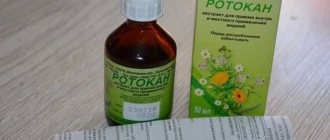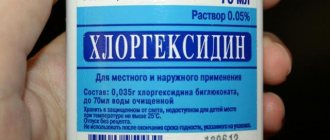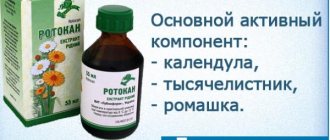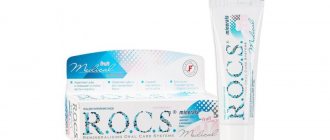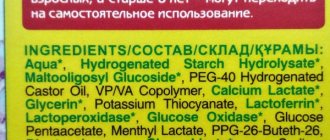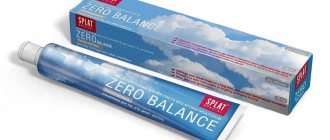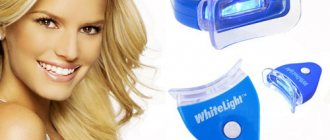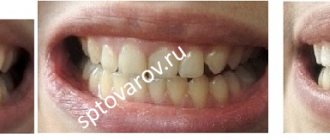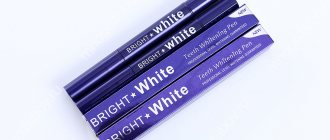Composition and release form
Rotokan is intended for external and internal use. Sold in the form of an aqueous-alcoholic extract.
The drug contains natural ingredients. These are chamomile, yarrow and calendula. This plant complex strengthens the capillary wall, providing a pronounced homeostatic effect. It also helps restore the integrity of the mucous surface and exhibits an antimicrobial effect.
When used orally, the product improves the functioning of the gastrointestinal tract.
Available in bottles of 25, 50 or 100 ml. The set includes a dropper dispenser and instructions for use. The extract is a liquid with a dark brown tint and a specific odor.
Ethyl alcohol acts as an excipient.
Dispensed from the pharmacy without a doctor's prescription.
What is rotokan used for?
The drug helps reduce pain during inflammation of the mucous surfaces of the upper respiratory tract, stomach, and rectum. Thanks to the use of the solution, the risk of purulent complications is reduced. Epithelization of the mucous membrane occurs faster.
What does Rotokan help with dental diseases:
- bleeding during tooth extraction;
- damage to the mucosa;
- oral infection;
- painful sensations.
Not all areas of application are described in the official instructions for the drug, since it was created and tested only for certain groups of diseases. During the use of the product, new directions appeared.
Rotokan for flux is a good antiseptic for the oral cavity. The solution is convenient to use at home, at work, on the road. Using a herbal preparation allows you to reduce the use of analgesics.
Rotokan for sore throat is a symptomatic remedy that reduces the intensity of local manifestations of the inflammatory process. Rinse should be so that the solution gets onto the mucous membrane of the pharynx and tonsils.
Inflammation in acute tonsillitis occurs in the palatine tonsils. Gargling with Rotokan for a sore throat helps to quickly get rid of discomfort in the throat. The mucous membrane heals faster, the protective properties of the tonsils are restored.
Rotocan for pharyngitis and tracheitis is mainly used for inhalation during the temperature-free period of the disease. The same procedures help ease breathing when you have a runny nose.
Rotokan is used for coughs to better liquefy mucus in the respiratory tract. The components of the plant extract activate the body's defenses (immunity).
Rotokan in gynecology is used for sitz baths. The procedure is prescribed for inflammatory and infectious diseases: thrush, vaginitis, colpitis.
In dermatocosmetology practice, there are methods for using Rotokan for acne and acne, minor skin damage (cuts, abrasions, cracks, ulcers). The product is applied to disinfect and stimulate healing.
Therapeutic effect
Rotokan belongs to the group of herbal remedies with complex action. The main pharmacological property is anti-inflammatory. Provided thanks to plant extracts.
The drug has the following therapeutic effects:
- Antiseptic - observed due to the content of chamomile and ethyl alcohol in the composition. Helps against a large number of gram-positive bacteria.
- Antispasmodic - herbs have a pronounced sedative effect, can relieve muscle hypertonicity and muscle tension in internal organs.
- Restorative – rapid regeneration of epithelial cells is noted, effective for ulcerative lesions.
- Hemostatic - the natural components of the drug strengthen the vascular and capillary walls, preventing the development of minor bleeding.
- Analgesic – achieved in combination with a number of pharmacological properties.
Rotocan vialine tab for dispensing. 20 pcs
Active substance:
EMDEX® dextrate filler, dry chamomile flower extract, dry yarrow herb extract, dry calendula flower extract, ascorbic acid, microcrystalline cellulose filler, basic anti-caking agent magnesium carbonate, natural orange flavor, anti-caking agents: talc and magnesium silicate;
sweeteners: sucralose and sodium saccharinate. Description:
Rotocan Vialine lozenges based on plant extracts containing vitamin C.
Properties of the constituent components.
Vitamin C - Ascorbic acid Ascorbic acid takes part in the following chemical processes in the human body: the formation of collagen, serotonin from tryptophan, the formation of catecholamines, the synthesis of corticosteroids. Ascorbic acid is also involved in the conversion of cholesterol to bile acids. Vitamin C itself neutralizes the superoxide radical to hydrogen peroxide. Restores ubiquinone and vitamin E. Stimulates the synthesis of interferon, therefore, participates in immunomodulation. Converts ferric iron to divalent iron, thereby promoting its absorption. Inhibits the glycosylation of hemoglobin, inhibits the conversion of glucose to sorbitol. People must obtain ascorbic acid from food, since the gene responsible for the formation of one of the enzymes for the synthesis of ascorbic acid is non-functional.
Chamomile flowers Chamomile flowers include a large complex of chemical elements. It combines bisabol oxide and essential oil, cadinene, farnesene, coumarin, choline, polysaccharides, phytosterol, and fatty acid glyceride in ideal proportions. Among the biological acids in its composition, noyl and isovaleric acid are distinguished. This flower also has antibacterial properties due to the presence of flavonoids in its composition. These include quercetin, luteolin and aigenin. Only due to the presence of all these elements in the composition, chamomile has antimicrobial and antiviral properties. Chamomile flowers are useful in the treatment of colds and viral diseases. It is also used for gas formation in the intestines. This flower is also useful for improving digestion. By stimulating the secretion of gastric juice through a gentle effect on the digestive tract and intestinal mucosa, chamomile increases appetite. Chamomile flowers are a good adsorbent, as due to their beneficial properties they absorb toxins.
Common yarrow herb Common yarrow herb contains up to 0.8% essential oil (it contains chamazulene, millefolide, borneol, cineole, camphor, thujol, etc.), tannins, vitamins C, K, bitterness (achillein), flavonoids ( rutin, luteolin, etc.), saponins, macro- and microelements and other biologically active substances. Common yarrow herb has hemostatic, anti-inflammatory, bactericidal properties, increases appetite, and increases bile secretion. Leaves, young shoots and flowers are used in cooking. Yarrow herb is used fresh as a seasoning for cooking meat and fish, and added to salads and vinaigrettes. Dried leaves and flowers are used in liqueurs and infusions, table wines and kvass, jellies and mousses. When using yarrow as a spice, you should be careful. If consumed excessively, poisoning may occur, which will manifest itself in dizziness and skin rashes. People with increased blood clotting and a tendency to form blood clots are not recommended to take yarrow preparations.
Calendula flowers Calendula flowers contain up to 3% carotenoids and up to 0.8% flavonoids. Carotenoids include lutein, triterpene saponins (2-10%) and polysaccharides (up to 15%). The smell of flowers and their phytoncidal properties are due to the presence of essential oils, which contain 0.02% in the flowers of the plant. The flowers also contain the bitter substance calenden (up to 19%), up to 4% mucus, up to 3.4% resins, phytoncides, organic acids, glycosides, tannins, saponins, up to 8% organic acids, vitamin C, potassium, calcium, magnesium, a number of trace elements, etc. In the food industry, calendula flowers are used to flavor and color cheese and butter, as a seasoning for soups, salads, and stews.
Release form:
20 lozenges weighing 800 mg
Instructions for use
The drug can be taken orally, topically and rectally. Each method has some features.
The extract is not used in its pure form; before use, the product is first diluted with water.
The course of therapy depends on the diagnosis, the age of the patient and the severity of the pathological process. For dental diseases, it is effective to rinse and apply applications. This is relevant for the treatment of stomatitis and other inflammatory lesions of the mucous membrane. Use a diluted solution, 1 teaspoon of the drug per 200 ml of water. In Rotokan, cotton swabs are moistened and applied to the affected areas for 25 minutes. The frequency of procedures is up to 4 times a day for a week.
Treatment of periodontal tissue with a solution is carried out immediately after removing plaque, tartar and cleaning the gum pockets from pathological contents. To do this, turundas soaked in Rotokan are placed in the periodontal areas for 20 minutes. The duration of the procedure is up to 6 manipulations, 1 time per day.
For pathologies of the gastrointestinal tract, the medicine can be taken rectally and orally in diluted form.
For internal use, the course of therapy is 10 days, maximum 3 weeks. The solution is drunk 2-4 times a day, 130 ml. Take 30 minutes before meals or an hour after meals.
To administer microenemas, 1 teaspoon of Rotokan is diluted in 100 ml of warm water. The procedure is carried out after emptying the intestines up to 2 times a day. The maximum course of treatment is 3 weeks.
The antiseptic drug is also effective for sore throats. In this case, rinse for 7 days with a low concentration solution.
Indications for use
For inflammation of various etiologies, dentists and ENT doctors often prescribe Rotokan to patients. Germs and damage, burns can cause bleeding, pain and swelling.
For stomatitis, the medicine is very effective at the first stage of the pathology. It affects bacterial and fungal infections and quickly destroys them.
Indications for treatment with Rotokan for dental pathologies:
- periodontal disease
- tooth socket disease
- periodontitis
- gingivitis
- various stomatitis
- necrotizing gingivostomatitis
For pathologies of the pharynx and tongue, the drug is used for rinsing.
Treatment with Rotokan helps reduce inflammation with tonsillitis, pharyngitis, and glossitis.
Pathologies of the digestive system when the drug is prescribed orally:
- gastroduodenitis
- enterocolitis
- gastritis with low acidity of gastric contents
- chronic enteritis, inflammation
- functional dyspepsia
special instructions
It is not recommended to exceed the duration of the course without consulting a specialist. If there is no positive dynamics in treatment, you must stop taking the medication and consult a doctor.
People suffering from high stomach acidity should take the drug with caution. In this case, antacids should be used in parallel.
Rotokan is not prescribed for children. This is due to the high risk of allergic reactions.
Since the medicine contains ethyl alcohol, it is not advisable for alcohol addicts and people with impaired liver function or excretory system to take it.
The drug should be used with caution in the elderly to avoid the development of adverse reactions.
Contraindications, side effects, overdose
Rotocan is not prescribed to persons who have been diagnosed with individual hypersensitivity to individual components of the extract or to the drug as a whole. Among the ingredients there is ethanol - about 30 ml. in every 100 ml. extract.
- Due to the presence of alcohol, Rotokan contraindications include alcoholism, serious illnesses and brain injuries.
- Rotokan is not prescribed during pregnancy, severe renal and liver failure.
- Age limit is under 18 years of age.
- Rotokan is contraindicated during breastfeeding.
Children's dosages are not indicated in the instructions. Sometimes Rotokan solution is given to children over 12 years of age for rinsing and inhalation, but only after consultation with a pediatrician.
Among the undesirable effects of the drug are allergic reactions in the form of:
- redness;
- itchy skin;
- rashes;
- nausea;
- vomiting.
In case of an overdose, dizziness may occur. The symptoms will be similar to those of alcohol intoxication. It is necessary to stop using the extract and rinse the stomach.
Indications and contraindications
The medicine is used for therapy:
- gingivitis, stomatitis, periodontitis and other pathologies with inflammation;
- proctitis, paraproctitis.
The medication is not recommended for use in case of individual intolerance to individual components, or allergies to representatives of the Asteraceae family.
The list of contraindications is presented:
- carrying a baby and breastfeeding;
- a ban on admission until the age of twelve;
- ulcers of the digestive system;
- diseases of the biliary tract and bladder;
- liver pathologies;
- epileptic seizures;
- alcohol dependence, head injury;
The solution is not used for patients with a reduced threshold for convulsive readiness - when using enemas.
When is the drug contraindicated?
Before use, you should familiarize yourself with the contraindications for using Rotocan extract:
- pregnancy and breastfeeding;
- brain diseases;
- traumatic brain injuries;
- severe renal dysfunction;
- alcoholism;
- adolescence (up to 18 years of age) - this prohibition applies to oral use;
- individual intolerance to at least one of the components of the drug Rotokan.
The instructions also consider situations when the drug should be used with extreme caution - that is, under the supervision of a doctor or in consultation with him. This is due to insufficient knowledge of the likelihood of side effects when using Rotocan extract for certain diseases:
- Pyelonephritis.
- Glomerulonephritis.
- Renal dysfunction.
In other cases, Rotocan is usually well tolerated by patients.
Tips for using a nebulizer
The nebulizer is a fairly easy-to-use device, so operating difficulties rarely arise. Before the first use, you should carefully study the instructions, correctly assemble the device and find the hole for introducing the medicinal solution.
Before each procedure, the mask or attachment should be wiped with cotton wool soaked in medical alcohol. This will reduce the number of bacteria. After completing the course of treatment, the mask must be washed with soap, wiped again with alcohol and left to dry.
After each inhalation, it is necessary to disassemble and wash the mask and tubes, and leave them disassembled until dry. This will extend the life of the device. It is strictly forbidden to leave the device turned on for a long time after the entire medicinal solution has evaporated.
